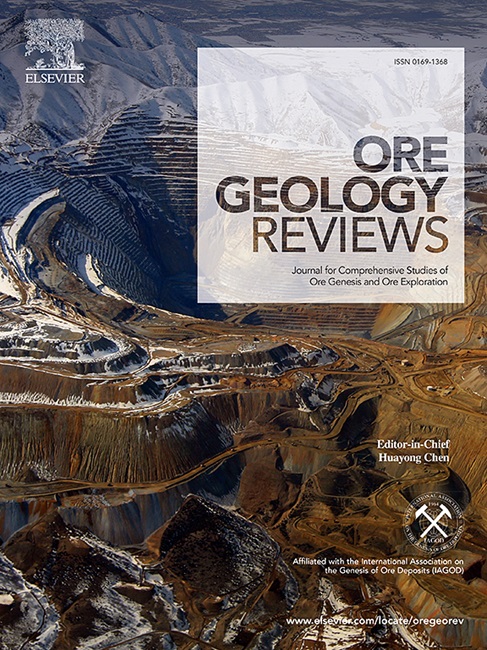Recurrent granite-related mineralization along former Tethys sutures in southwestern China
IF 3.2
2区 地球科学
Q1 GEOLOGY
引用次数: 0
Abstract
The sutures of the Paleo-Tethys, Meso-Tethys, and Neo-Tethys oceans in southwestern China host many major porphyry- and/or granite-related mineral deposits. We compile age and geochemical data from these deposits. The age data show that most of these deposits are not related to the formation of the sutures, but to their later tectonic reactivation. For instance, intrusion-related deposits along fault zones in the Sanjiang area, which represent the suture of the former Paleo-Tethys Ocean, fall in one of the four age groups: 239–206 Ma, 182–162 Ma, 126–70 Ma, and 53–32 Ma. The oldest group of major porphyry- and/or granite-related deposits in the Sanjiang zone is related to the subduction and closure of the Paleo-Tethys Ocean, whereas younger deposits formed during the reactivation of Paleo-Tethys sutures during the closure of the Meso-Tethys and the Neo-Tethys oceans and during the India–Asia collision. Different types of coeval porphyry- and/or granite-related deposits occur along different segments of the same crustal-scale structure and are related to different types of intrusions: Cu (![]() Mo), Cu
Mo), Cu![]() Au, Au, and Mo (
Au, Au, and Mo (![]() Cu) porphyry or skarn deposits are associated with relatively oxidized rocks that were derived from the melting of subduction-modified mantle with variable contributions from the crust and W
Cu) porphyry or skarn deposits are associated with relatively oxidized rocks that were derived from the melting of subduction-modified mantle with variable contributions from the crust and W![]() Mo and Sn
Mo and Sn![]() W deposits are related to highly evolved, reduced porphyries and/or granites that originated from partial melting of metasedimentary rocks. Although the inventory of sedimentary source rocks along the sutures is controlled by the geological development before the suture formed, the later reactivation of the suture determines which source rocks become available for melting and, thus, which type of mineralization may form along different reactivated segments.
W deposits are related to highly evolved, reduced porphyries and/or granites that originated from partial melting of metasedimentary rocks. Although the inventory of sedimentary source rocks along the sutures is controlled by the geological development before the suture formed, the later reactivation of the suture determines which source rocks become available for melting and, thus, which type of mineralization may form along different reactivated segments.

中国西南前特提斯缝合线沿线花岗岩相关矿化
中国西南部古特提斯、中特提斯和新特提斯海洋的缝合处有许多主要的斑岩和/或花岗岩相关矿床。我们收集了这些矿床的年龄和地球化学数据。年龄资料表明,这些矿床大多与缝合线的形成无关,而与缝合线后期的构造再活化有关。以三江断裂带为例,代表古特提斯洋前缝合带的侵入体相关沉积,可分为239 ~ 206 Ma、182 ~ 162 Ma、126 ~ 70 Ma和53 ~ 32 Ma 4个时代。三江地区最古老的主要斑岩和花岗岩相关矿床群与古特提斯洋的俯冲和闭合有关,而较年轻的矿床形成于中特提斯和新特提斯洋闭合期间古特提斯缝合线的重新激活以及印度-亚洲碰撞期间。不同类型的同时期斑岩和/或花岗岩相关矿床产于同一地壳尺度构造的不同段,与不同类型的侵入岩有关;Cu (Mo)、CuAu、Au和Mo (Cu)斑岩或矽卡岩矿床与俯冲变质地幔熔融形成的相对氧化岩有关,地壳的贡献不同;WMo和雪w矿床与变质沉积岩部分熔融形成的高度演化、还原斑岩和/或花岗岩有关。尽管缝合线形成前的地质发育控制了缝合线沿线沉积烃源岩的数量,但缝合线的后期再活化决定了哪些烃源岩可以熔化,从而决定了在不同的再活化段可能形成哪种类型的矿化。
本文章由计算机程序翻译,如有差异,请以英文原文为准。
求助全文
约1分钟内获得全文
求助全文
来源期刊

Ore Geology Reviews
地学-地质学
CiteScore
6.50
自引率
27.30%
发文量
546
审稿时长
22.9 weeks
期刊介绍:
Ore Geology Reviews aims to familiarize all earth scientists with recent advances in a number of interconnected disciplines related to the study of, and search for, ore deposits. The reviews range from brief to longer contributions, but the journal preferentially publishes manuscripts that fill the niche between the commonly shorter journal articles and the comprehensive book coverages, and thus has a special appeal to many authors and readers.
 求助内容:
求助内容: 应助结果提醒方式:
应助结果提醒方式:


